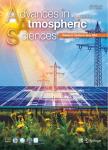Cloud Classification and Distribution of Cloud Types in Beijing Using Ka-Band Radar Data
Cloud Classification and Distribution of Cloud Types in Beijing Using Ka-Band Radar Data作者机构:Key Laboratory for Atmosphere and Global Environment Observation Chinese Academy of Sciences
出 版 物:《Advances in Atmospheric Sciences》 (大气科学进展(英文版))
年 卷 期:2019年第36卷第8期
页 面:793-803页
核心收录:
基 金:supported by the National Natural Science Foundation of China (Grant Nos. 41775032 and 41275040)
主 题:clouds clustering algorithm classification algorithm radar cloud type
摘 要:A cloud clustering and classification algorithm is developed for a ground-based Ka-band radar system in the vertically pointing mode. Cloud profiles are grouped based on the combination of a time–height clustering method and the k-means clustering method. The cloud classification algorithm, developed using a fuzzy logic method, uses nine physical parameters to classify clouds into nine types: cirrostratus, cirrocumulus, altocumulus, altostratus, stratus, stratocumulus, nimbostratus,cumulus or cumulonimbus. The performance of the clustering and classification algorithm is presented by comparison with all-sky images taken from January to June 2014. Overall, 92% of the cloud profiles are clustered successfully and the agreement in classification between the radar system and the all-sky imager is 87%. The distribution of cloud types in Beijing from January 2014 to December 2017 is studied based on the clustering and classification algorithm. The statistics show that cirrostratus clouds have the highest occurrence frequency(24%) among the nine cloud types. High-level clouds have the maximum occurrence frequency and low-level clouds the minimum occurrence frequency.



